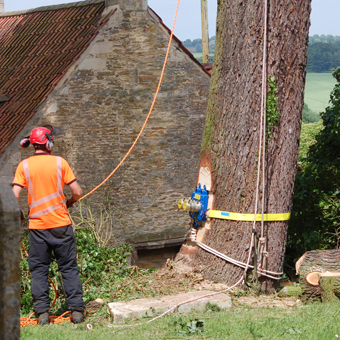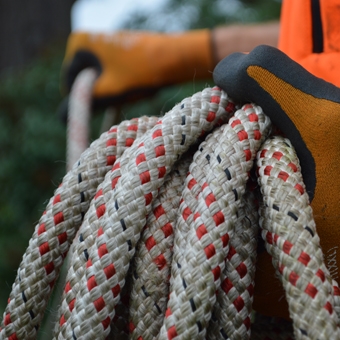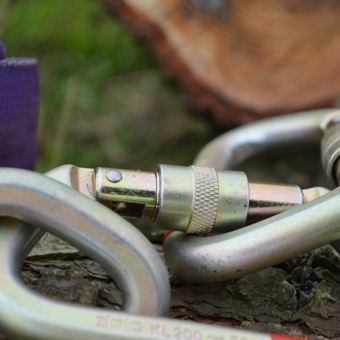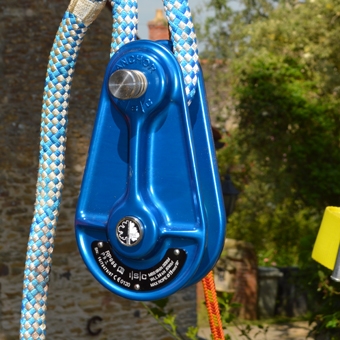
A Guide to Rigging Equipment
Whether it’s as simple as preventing damage to nearby shrubs by falling branches or as hazardous as pruning trees close to overhead powerlines, safety conforming lowering equipment is vital to professional arborists and tree surgeons.
Installed and used correctly rigging and lowering equipment prevents heavy branches from free falling to the ground at speed by lowering the load in a controlled descent. This allows tree care professionals to conduct their tasks safely and efficiently, minimising the risks of damage to the tree, the personnel and the surrounding area.
It’s important to know which lowering item of equipment to use for what purpose, so you can conduct your removal operations properly.
Here then, is our handy guide.
1. Lowering ropes and strops
Lowering ropes and strops are essential to take heavy branches from the tree canopy down to the ground.

You’ll likely want a variety of ropes on hand (13mm, 16mm and possibly 19mm) to cope with different loads and rigging scenarios. You’ll need to understand how to calculate a safe working load from a minimum breaking strain and appreciate the effect that terminations or knots have on the strength of a rope, as well as the effects of shock loading.
There are a wide range of reliable lowering ropes on the market today. Below are some of the best:
- The abrasion resistant Zega 16mm HeavyRig Bullrope (breaking strain 7800kg) – also available in 13mm and 19mm versions
- The 16-plait construction rope Marlowbraid Bullrope (breaking strain 7840kg without eye or 6520kg with eye)
- The supple 50-metre Marlow Draco rope (breaking strain 7550 kg)
Your ropes should also go hand-in-hand with durable strops, like our:
- Shizll Dead Eye Sling with ArboRing, perfect for quick rigging through the eye without the need for a pulley
- Spider Leg Balancer, made to be attached to lowering lines for balancing sprawling limbs without the need for excessive cutting
- Dead Eye Sling, with one spliced and protected eye for anchoring your block in the tree
- Whoopie Sling, used as an anchor for flying capstans or Port-a-wraps at the base of the tree
- Round Sling, filament slings often used for choking around the limb to be lowered
2. Karabiners and Shackles
A professional arborist’s toolkit will not be complete without some steel karabiners and shackles. Small yet sturdy, karabiners are essential to quickly and reversibly connect components.

You should make sure your karabiners conform to European Union Standard EN362.
Some great karabiners and shackles for lowering work include:
- Steel Swivel Eye Karabiner – comes with a three-way locking gate, minimising the risk of the gate opening accidentally, and a swivel eye to help prevent lines from twisting (minimum breaking strain: 35kN)
- Iron Wizard Karabiner – comes with an off-axis gate, allowing a bigger entry area for easier insertion of slings and other items (minimum breaking strain: 70kN)
- D-Shackle – a steel shackle marked with load rating on the yoke (working load limit: 2.0 tonnes)
- Big Dan steel karabiner – a large 3-way karabiner (minimum breaking strain: 50kN)
3. Winches, Bollards and Capstans
Designed to help arborists manoeuvre trees or stumps, winches are made of a strong steel body with a handle to tension the steel wire cable, enabling the user to pull or lift a very heavy load.
Bollards and Capstans serve the same purpose – as a friction device to help control a loaded lowering line. Both are fixed to the trunk of the tree, but a bollard is mounted on the trunk with straps and remains static whether under load or not, whereas a capstan relies on the tension of the rigging line to pull it into position. A bollard, although more expensive, is an easier tool to use and depending on the type will often take a bigger rope.
Winches,bollards and capstans are integral to lifting and lowering procedures in tree work, so you need to be sure of their suitability for the task in hand, as they can be dangerous when used incorrectly.
Any such device should be able to support the appropriate load and be marked to show the maximum load. Below are some examples:
- Wire Rope Hoist Winch – with a robust alloy body, this hoist winch can support up to 800kg loads with 1,250kg pull capacity (also available in 1,600kg and 3,200kg lift capacity)
- Shear Pin – if you need replacement pins for your winch, our reliable shear pins can protect your machine from excessive stress
- Snatch Block Pulley – can be used with 8mm wire rope, it comes with a swivel hook safety catch and 3 sheave
- Flying Capstan – used as a friction break-in lowering operations, this flying capstan (also known as a port-a-wrap) allows to lower heavy loads in a controlled manner
4. Pulleys and Blocks
Rigging pulleys and blocks are used in accomplishing vital tree care applications, such as hitch advancement or multiple system rigging. In the arborist industry, pulleys and blocks have similar functions but have different applications.

Blocks, on the one hand, are designed to take heavy loads in multiple rigging systems. As such, they are composed of a bushing for sling attachment and a locking mechanism.
Pulleys, on the other hand, do not come with a bushing, they’re lighter weight, and typically have a much lower breaking strain. Their thin metal cheek plates can be attached to a sling for static rigging systems.
Pulleys can be used in a variety of scenarios, including the pre-tensioning of a rigging line to remove slack and minimise shock-loading.
Take a look below for some examples:
- Fiddle Block – a pulley system that comes with triple sheave system, hard anodized aluminium sheaves, and integrated cam to control the rope’s progress
- Swing Cheek Pulley – its pivoting cheeks are made for easier rope installation
- Twin Pulley – made for compound pulley systems and hauling heavy loads, with large holes for karabiners
- Pulley Blocks – can be used as main anchor for lowering procedures, with working load of 2 tonne and breaking strain of 100kN to 150kN (depending on size)
- Rigging Plate – comes with a max breaking strain of 30kN or 45kN
Safe And Efficient Equipment
With the right lowering device, you can perform your tasks in a way that would extend the life of your equipment, protect the trees, and minimise risks of tree-related injury.
Do keep in mind that these are complex pieces of equipment. As such, you need to make sure you are fully trained on how to use them correctly before you use them in a workplace environment. Some of these tools can be extremely dangerous and cause accidents when used incorrectly.
If you need help picking the right lowering equipment, give us a call on 01780 482231 or drop us an email at sales@landmarktrading.co.uk and we’d be happy to talk through your requirements.
